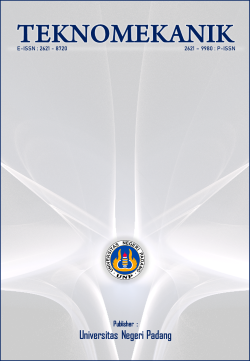A comparison of the sensory evaluation on the use of fresh and dried seasoning in beef rendang
DOI:
https://doi.org/10.24036/jptk.v3i3.13423Keywords:
Beef rendang, Dried seasoning, Fresh seasoning, Sensory evaluationAbstract
Beef rendang is a popular traditional food from West Sumatra which is commonly cooked by using fresh seasoning such as herbs and spices yet not all types of those ingredients are effortlessly available to be found. This issue hinders the local community to cook beef rendang with the original taste of West Sumatra. As a matter of fact, producing dried seasoning to cook rendang could be a possible solution to solve this issue. This study aimed to compare the sensory analysis of beef rendang by using fresh and dried seasoning. This sort of research was a pure experiment with a completely randomized design and 3 repetitions. The ingredients being used are beef, coconut milk, chilies, ginger, galingale, lemongrass, shallots, garlic, lime leaves, bay leaves, turmeric leaves and salt, cooking oil, nutmeg and coriander purchased at traditional markets. The seasoning was sautéed and the coconut milk was poured into the pan, then the beef was added onto the coconut milk with the seasoning until it is half cooked in which the name is Kalio (Like curry, but not become rendang yet), then it was heated up and dried up for hours until the coconut milk dried and turned black which is called rendang. In addition, the data collection technique was carried out by giving a questionnaire to the panelists. The data analysis used was the t-test independent sample t-test using SPSS 15.0 software. The results obtained from the research showed that the average values of the sensory evaluation of the two rendang were almost similar. The average values of beef rendang sensory evaluation using fresh and dried seasoning, respectively, were colour 3.26 and 3.53; aroma 4.0 and 4.13; the texture has the same value, namely 3,4; taste namely 4,6 and 4,46 and the hedonic test 4,33 and 4,20. These results were likely identical as what the statistical test attained (t-test) that there are no significant differences between beef rendang using dried seasoning and fresh seasoning for each sensory testing.
Downloads
References
Agusman. (2013). Pengujian Organoleptik. Program Studi Teknologi Pangan. Universitas Muhamadyah.
Astawan, M. (2020). Sehat dengan Rempah dan Bumbu Dapur. Penerbit Buku Kompas.
CNN. (2017). Your pick: world’s 50 best foods. https://edition.cnn.com/travel/article/world-best-foods-readers-choice/index.html
Dwi, W. (2019). Randang Bundo (1st ed.). PT.Gramedia Pustaka Utama.
Fadhila, R., & Darmawati, S. (2017). Profil Protein Daging Kambing, Kerbau Dan Sapi Yang Direndam Larutan Jahe Berbasis Sds-Page. Prosiding Seminar Nasional & Internasional, 0, 25–33. http://eriset.unimus.ac.id/index.php/psn12012010/article/view/3109
Faridah, Anni, & Pramudia, H. (2019). Roti. CV IRDH.
Faridah, A., Yuliana, & Rahmi, H. (2013). Ilmu Bahan Makanan Bersumber Dari Nabati. Gifari Prasetama.
Hambali. (2005). Membuat Aneka Bumbu Instan Instan Kering. Penebar Swadaya.
Hariadi. (2012). Inventarisasi Perlindungan Karya Budaya Randang Minangkabau (E. D. Krisna (ed.); 1st ed.). BPSNT Padang Press.
Helena, D., Bastos, M., Shibao, J., Ferreira, E. L., & Bombo, A. J. (2011). Maillard reaction products in processed food. Nutrire, 36(3), 63–78.
Kusumawardhani, Y., Juke, S., & Ratri, A. (2017). Dried Spice Technology Improves Effeciency in the Hospitality Industry. Advances in Economics, Business and Management Research, 28(16), 37–41. https://doi.org/10.2991/ictgtd-16.2017.7
Melia, S., Novia, D., & Juliyarsi, I. (2015). Antioxidant and Antimicrobial Activities of Gambir ( Uncaria gambir Roxb ) Extracts and Their Application in Rendang. Pakistan Journal of Nutrition . 14 (12), 938–941.
Nazir, N., Anggraini, T., & Rahayu, L. (2018). Principal component analysis for sensory profiling of rendang from various region in West Sumatra. International Journal on Advanced Science, Engineering and Information Technology, 8(2), 596–603. https://doi.org/10.18517/ijaseit.8.2.5279
Prasetio, A. (2014). Pengaruh santan segar dan santan instan terhadap mutu organoleptik dan fisik rendang daging. Skripsi. Teknologi Hasil Pertanian, Fakultas Teknologi Pertanian, Universitas Jember
Prasetyo, F. (2003). Penentuan Kondisi Pengolahan Dan Penyajian Bumbu Rawon Instan Bubuk Dengan Metode Taguchi. Jurnal Teknik Industri, 5(2), 90–100. https://doi.org/10.9744/jti.5.2.pp.90-100
Rini, Azima, F., Sayuti, K., & Novelina. (2016). The Evaluation of Nutritional Value of Rendang Minangkabau. Agriculture and Agricultural Science Procedia, 9, 335–341. https://doi.org/10.1016/j.aaspro.2016.02.146
Sebayang, N. S., & Siahaan, S. G. K. dan S. (2018). Mutu rendemen dan uji organoleptik tepung cabai (capsicum annuum). Prosiding Seminar Nasional Biotik. 569–578.
Shadri, S., Moulana, R., & Safriani, N. (2018). Kajian pembuatan bubuk serai dapur (cymbopogon citratus) dengan kombinasi suhu dan lama pengeringan. Jurnal Ilmiah Mahasiswa Pertanian Unsyiah, 1(3), 371–380. www.jim.unsyiah.ac.id/JFP
Suliasih, N., & Nurminabari, I. S. (2018). Pengaruh Formula Dan Perbandingan Bumbu Serbuk Dengan Santan Serbuk Terhadap Karakteristik Bumbu Gulai Serbuk Dengan Metode Foam-Mat Drying. Pasundan Food Technology Journal, 4(3), 167. https://doi.org/10.23969/pftj.v4i3.645
Wang, D., Lin, H., Kan, J., Liu, L., Zeng, X., & Shen, S. (2012). Food chemistry. In Food Chemistry. https://doi.org/10.1201/9781003066422-4
Winarno, F. G. (2003). Kimia Pangan dan Gizi. Gramedia Pustaka Utama.
Downloads
Published
How to Cite
Issue
Section
License
Copyright (c) 2020 Berhias Mentari

This work is licensed under a Creative Commons Attribution 4.0 International License.





